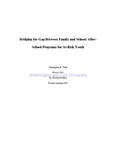| dc.rights.license | In Copyright | en_US |
| dc.creator | Tittle, Christopher A. | |
| dc.date.accessioned | 2013-12-17T17:37:01Z | |
| dc.date.available | 2013-12-17T17:37:01Z | |
| dc.date.created | 2007 | |
| dc.identifier | WLURG38_Tittle_POV_2007_wm | |
| dc.identifier.uri | http://hdl.handle.net/11021/26014 | |
| dc.description | Christopher A. Tittle is a member of the Class of 2007 of Washington and Lee University. | en_US |
| dc.description | Capstone; [FULL-TEXT FREELY AVAILABLE ONLINE] | en_US |
| dc.description.abstract | Although the potential benefits of expanded after-school programming should be offered to all children, the focus of this paper will be exclusively on low-income, minority students -- those that face significant structural barriers to success on a constant basis. As a result of such barriers, a substantial achievement gap between low-income and minority students and their more affluent peers has persisted for decades. Encouragingly though, many studies are now finding that students who are the most at-risk for academic failure generally benefit more from structured after-school programs. Programs that provide specific activities that serve an established goal and operate on a consistent timeframe offer the most structure, and often the greatest impact. Additionally, since more studies have documented the potentially positive effects of early childhood programming, this paper will focus on programs available to adolescents in their middle and high school years. Because these are the years when students are the most at-risk of disengaging from academic pursuits and becoming involved in dangerous activities such as crime and drug-use, programs targeted at this age group represent a crucial concern for society. [From introductory section] | en_US |
| dc.format.extent | 26 pages | en_US |
| dc.language.iso | en_US | en_US |
| dc.rights | This material is made available for use in research, teaching, and private study, pursuant to U.S. Copyright law. The user assumes full responsibility for any use of the materials, including but not limited to, infringement of copyright and publication rights of reproduced materials. Any materials used should be fully credited with the source. | en_US |
| dc.rights.uri | http://rightsstatements.org/vocab/InC/1.0/ | en_US |
| dc.subject.other | Washington and Lee University, Shepherd Poverty Program | en_US |
| dc.title | Bridging the Gap Between Family and School: After-School Programs for At-Risk Youth | en_US |
| dc.type | Text | en_US |
| dcterms.isPartOf | RG38 - Student Papers | |
| dc.rights.holder | Tittle, Christopher A. | |
| dc.subject.fast | After-school programs | en_US |
| dc.subject.fast | School management and organization | en_US |
| dc.subject.fast | Public-private sector cooperation | en_US |
| dc.subject.fast | At-risk youth -- Services for | en_US |
| dc.subject.fast | Intersectionality | en_US |
| local.department | Shepherd Poverty Program | en_US |
| local.scholarshiptype | Capstone | en_US |
